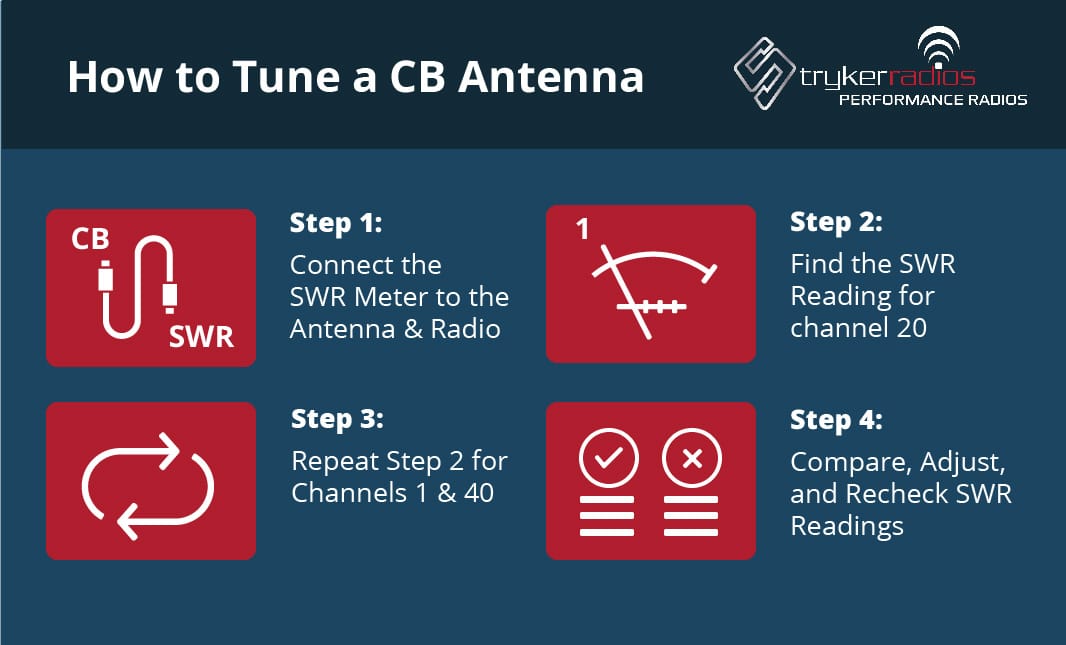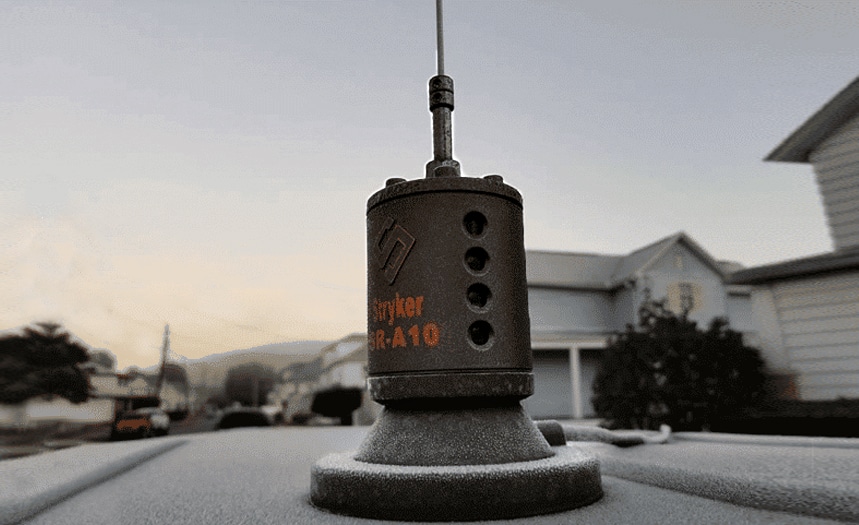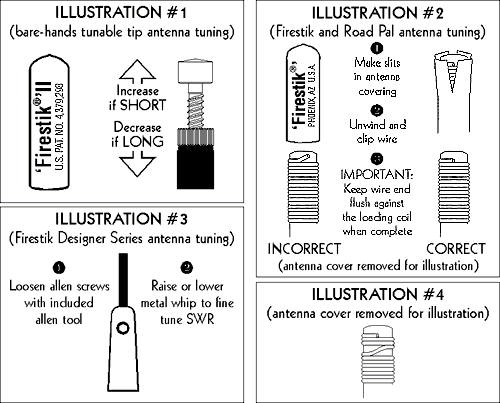How to Tune CB Radio Antenna: Expert Tips for Best Reception

Tuning a CB radio antenna is crucial for clear communication. It ensures strong signal and reduces interference.
For those new to CB radios, getting the best performance can be tricky. One essential step is tuning the antenna correctly. Without proper tuning, even the best radio will not work well. This process aligns the antenna with your radio, making sure you get the best range and clarity.
In this guide, we will walk you through the steps to tune your CB radio antenna. You will learn how to maximize your radio’s performance, ensuring you stay connected. Whether for work or leisure, a well-tuned antenna is key. Let’s dive in and make sure your CB radio is set up for success.
Choosing The Right Antenna
Choosing the right antenna is crucial for optimal CB radio performance. The right choice ensures clear communication and extends the range of your radio. Let’s explore the different types of CB antennas and the factors to consider when making your choice.
Types Of Cb Antennas
There are several types of CB antennas, each with its own benefits. The main types are fiberglass, magnetic mount, and whip antennas. Fiberglass antennas are durable and flexible, making them ideal for rough environments. Magnetic mount antennas are easy to install and remove, perfect for temporary setups. Whip antennas offer the best range but can be quite tall and less convenient for some vehicles.
Factors To Consider
When choosing a CB antenna, consider the length and mounting location. A longer antenna generally provides better range. However, it also needs a secure mounting spot. The mounting location affects the antenna’s performance. Roof mounts offer the best range, while bumper mounts are more practical for larger vehicles. Another factor is the material of the antenna. Fiberglass is strong and flexible, while stainless steel is more durable but less flexible.
Lastly, think about the ease of installation. Some antennas require drilling holes, while others use magnetic mounts. Choose one that fits your skill level and vehicle type. By considering these factors, you can select the best antenna for your needs, ensuring clear and reliable communication.
Installing The Antenna
Installing the antenna on your CB radio is crucial for optimal performance and communication. A well-installed antenna ensures you get the best signal possible, leading to clear and uninterrupted conversations. Let’s dive into the key aspects of installing your CB radio antenna correctly.
Mounting Options
Choosing the right mounting option for your CB radio antenna is essential. You have several choices, such as magnetic mounts, mirror mounts, and permanent mounts.
Magnetic mounts are convenient and easy to install. They allow you to reposition the antenna easily, which is great if you frequently change vehicles.
Mirror mounts are popular for trucks and larger vehicles. They provide a sturdy base and are less likely to be affected by wind and movement.
Permanent mounts are the best option for a long-term setup. They require drilling into the vehicle but provide the most secure and stable connection.
Consider your needs and vehicle type when selecting a mounting option. Think about how often you’ll need to move the antenna and the importance of stability and security.
Cable Connections
Once you’ve mounted your antenna, the next step is to connect the cables correctly. Proper cable connections ensure that your antenna works efficiently.
First, use a high-quality coaxial cable. This type of cable minimizes signal loss and interference. Ensure the cable is long enough to reach from the antenna to your CB radio without stretching or bending sharply.
Connect one end of the coaxial cable to the antenna. Make sure it’s tightly secured to avoid any signal loss. Then, route the cable carefully through your vehicle to the CB radio.
When routing the cable, avoid sharp bends and keep it away from electrical wiring to prevent interference. Use cable ties to secure the cable and keep it tidy.
Finally, connect the other end of the cable to your CB radio. Double-check all connections to make sure they’re tight and secure. A loose connection can lead to poor performance and frustration.
How do you know your connections are solid? Try testing your setup. If you’re getting clear reception and strong signals, you’re on the right track.
Installing a CB radio antenna might seem daunting, but with the right mounting option and proper cable connections, you’ll be set for smooth communication. Have you tried different mounting options or cable setups? Share your experiences in the comments below!
Understanding Swr
Understanding SWR is crucial when tuning your CB radio antenna. SWR, or Standing Wave Ratio, can seem complicated at first, but mastering it ensures your CB radio performs at its best. A properly tuned antenna means clearer communication and less interference.
What Is Swr?
SWR stands for Standing Wave Ratio. It’s a measure of how efficiently your antenna transmits the power from your CB radio. Think of it like a grade for your antenna’s performance.
A lower SWR means more power is going out through the antenna rather than being reflected back. This leads to better signal quality and range.
To measure SWR, you use an SWR meter. This handy device connects between your CB radio and the antenna. When you transmit, it shows the ratio of forward power to reflected power.
Importance Of Low Swr
Why is low SWR important? A low SWR ensures that your CB radio is working efficiently. It means less power is wasted, and more is used for your signal.
High SWR can damage your radio. When too much power is reflected back, it can cause overheating and potentially harm the radio’s internal components.
Additionally, low SWR improves your communication range. With a well-tuned antenna, your signals travel farther and clearer.
Imagine being on a long road trip. You want to stay in touch with your convoy. A low SWR ensures your messages are heard loud and clear, even at a distance. Have you ever experienced frustration with weak signals? Tuning your antenna to achieve low SWR can solve this problem.
So, always aim for an SWR reading as close to 1:1 as possible. This indicates nearly perfect efficiency. However, an SWR of up to 1.5:1 is generally acceptable for most CB radios.
Credit: www.rightchannelradios.com
Using An Swr Meter
Adjusting a CB radio antenna becomes easy with an SWR meter. This tool helps fine-tune your antenna for the best signal. Ensuring proper tuning improves communication clarity.
When tuning your CB radio antenna, using an SWR (Standing Wave Ratio) meter is essential. This tool helps you ensure your antenna is at its peak performance, providing clear and strong communication. Let’s dive into the steps involved in using an SWR meter for tuning your CB radio antenna effectively.Setting Up The Meter
First, connect the SWR meter between your CB radio and the antenna. Use a short coaxial cable to link the radio to the SWR meter’s “transmitter” port. Then, attach the antenna cable to the “antenna” port on the meter. Make sure everything is securely connected. Loose connections can skew your readings. Turn on your CB radio and set it to channel 1. This is where you’ll start your testing.Interpreting Readings
Now, key the microphone to transmit. Look at the meter and note the reading. A good SWR reading is generally below 1.5. Anything above 2.0 indicates potential issues that need addressing. Switch to channel 40 and repeat the process. Compare the readings from channel 1 and channel 40. If the readings are higher on channel 40, your antenna is too long. Trim it slightly and retest. If higher on channel 1, the antenna is too short. Extending it can help. Remember, small adjustments can make a big difference. Always recheck your SWR readings after any change. Tuning your CB radio antenna using an SWR meter is a straightforward process. It ensures clear, reliable communication. Have you ever faced issues while tuning your antenna? Share your experiences and tips in the comments!Adjusting Antenna Length
Adjusting the antenna length is crucial for proper CB radio tuning. Start by lengthening or shortening the antenna until you achieve the best signal. This ensures clear communication and optimal performance.
Adjusting Antenna Length Properly adjusting your CB radio antenna length is crucial for clear communication. A well-tuned antenna ensures you’re getting the best performance from your CB radio. Let’s dive into some practical steps for adjusting the antenna length.Trimming Techniques
One common method to adjust your antenna is trimming. This involves cutting small sections of the antenna to reach the ideal length. It’s essential to do this slowly and methodically. Start by trimming just 1/8 inch at a time. Check the SWR (Standing Wave Ratio) after each trim. This careful approach prevents over-trimming, which can negatively impact performance. You might wonder, how do you measure SWR? Use an SWR meter. It’s a simple tool that helps you see how well your antenna is transmitting. If the SWR is high, it means your antenna needs more adjustment.Checking Improvements
After making adjustments, always check for improvements. Use the SWR meter to see if the ratio has improved. Ideally, you want the SWR to be as close to 1:1 as possible. This indicates optimal transmission and reception. Take your CB radio for a test drive. Notice any changes in signal clarity and range. Are you experiencing fewer dead spots? Are the transmissions clearer? These are good signs that your adjustments are working. Sometimes, even after careful trimming, the SWR might still be high. This could mean there are other factors at play, like grounding issues or interference. In such cases, it might be helpful to recheck your setup or consult a professional. Adjusting your antenna length can seem daunting, but with patience and the right tools, you can significantly enhance your CB radio experience. Have you tried any of these techniques? What improvements did you notice? Share your experiences in the comments below!
Credit: strykerradios.com
Grounding The Antenna
Getting the best performance out of your CB radio involves more than just plugging it in and turning it on. One critical aspect is grounding the antenna. Proper grounding can dramatically improve the clarity of your transmissions and receptions. Let’s dive into why grounding matters and explore effective grounding methods.
Why Grounding Matters
Grounding your CB radio antenna is crucial for enhancing signal quality and reducing interference. A well-grounded antenna ensures that the radio operates efficiently.
Without grounding, you might experience static, weak signals, or even damage to your equipment. Imagine trying to have a conversation over the radio, but all you hear is garbled noise. That’s the frustration poor grounding can cause.
When I first started using a CB radio, I neglected proper grounding. My signal was weak, and communication was unreliable. Grounding changed everything, making my radio conversations crisp and clear.
Effective Grounding Methods
Several grounding methods can be employed to ensure your antenna performs at its best. One popular method is using a dedicated ground wire.
Attach a ground wire from the base of the antenna to a metal part of your vehicle or a grounding rod driven into the earth. This creates a direct path for electrical currents, reducing noise and improving signal clarity.
Another method is grounding through the vehicle’s chassis. Most vehicles provide a good ground, but ensuring the antenna mount is securely connected to the chassis can make a significant difference.
Think about this: if your antenna isn’t properly grounded, you might be missing out on vital information during a road trip. Ensuring good grounding can mean the difference between receiving clear directions and getting lost.
Have you ever considered how grounding affects your CB radio experience? If not, it’s time to give it some thought and see the improvement for yourself.
Regular Maintenance
Regular maintenance of your CB radio antenna is essential for optimal performance. This ensures you have clear communication and a strong signal. Neglecting maintenance can lead to poor signal quality. This section covers key maintenance tasks, focusing on routine checks and preventing corrosion.
Routine Checks
Perform routine checks to keep your CB radio antenna in top condition. Inspect the antenna for any visible damage. Look for cracks, bends, or breaks. Check the connections to ensure they are tight and secure. Loose connections can cause signal loss. Make sure the coaxial cable is not worn or damaged. Replace it if necessary.
Test the SWR (Standing Wave Ratio) regularly. An SWR meter can help with this task. A good SWR reading is below 2:1. Higher readings indicate problems. Adjust the antenna length if needed to get a better reading. This keeps your CB radio performing well.
Preventing Corrosion
Corrosion can severely impact your antenna’s performance. To prevent corrosion, use a high-quality, weather-resistant antenna. Apply a thin layer of dielectric grease to connections. This helps to protect against moisture. Check for signs of rust regularly.
If you find rust, clean it off immediately. Use a wire brush to remove rust from metal parts. Apply a rust inhibitor to prevent further corrosion. Store your CB radio and antenna in a dry place when not in use. This reduces the risk of moisture damage.
Troubleshooting Reception Issues
Tuning your CB radio antenna can be tricky. Sometimes, you may face reception issues. These problems can be frustrating. But don’t worry. Many common issues can be fixed easily.
Common Problems
Several issues can affect your CB radio’s reception. One common problem is a loose connection. Check all cables and connections. If they are not tight, your reception will suffer.
Another issue could be interference. Electrical devices nearby can cause static. This will disrupt your signal. Also, your antenna placement matters. If it is too close to metal objects, it will not work well.
Solutions And Fixes
Start with the basics. Ensure all connections are secure. Tighten any loose cables. This simple step can improve your reception.
Reduce interference. Move your CB radio away from other electrical devices. This can help clear up static. Also, consider the placement of your antenna. Place it in a location free from obstructions. This helps in getting a clear signal.
Check your antenna’s SWR (Standing Wave Ratio). An SWR meter can help with this. A high SWR means poor reception. Adjust the length of your antenna to lower the SWR. This can make a big difference.

Credit: www.firestik.com
Frequently Asked Questions
How To Tune In A Cb Antenna?
To tune a CB antenna, adjust the antenna length using a SWR meter. Ensure the SWR reading is below 1. 5. Fine-tune by adjusting the antenna tip.
What Happens If You Don’t Tune A Cb Antenna?
An untuned CB antenna reduces signal strength and range. It can also damage your CB radio due to high SWR.
How Can I Improve My Cb Radio Signal Strength?
Improve CB radio signal strength by upgrading your antenna, ensuring proper grounding, using quality coaxial cables, and eliminating interference sources.
What Channel Do You Calibrate Cb Radio On?
Calibrate your CB radio on channel 1 or channel 40. These channels are typically used for tuning.
Conclusion
Tuning your CB radio antenna enhances communication clarity. Follow these simple steps. Adjust the antenna length carefully. Use the SWR meter to check signal strength. Make small changes for better results. Secure connections tightly to avoid interference. Regular maintenance keeps your system optimal.
Test your setup frequently for best performance. Clear communication is crucial, especially on the road. By tuning your antenna, you ensure seamless connectivity. Enjoy uninterrupted conversations with fellow travelers. The right settings make all the difference. Happy tuning and safe journeys ahead.
